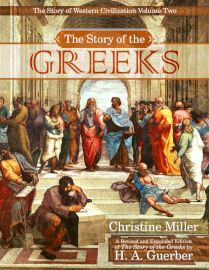Christine Miller authored All through the Ages: History through Literature Guide, a resource for selecting "real books" for history. Christine recommends using at least one overview or “spine” type book for each historical era in addition to titles that might focus on particular people and events. (An overview or spine book functions like a history text in covering the broad range of events in chronological order.) Because it can be difficult to find appealing overview books written from a Christian perspective, Christine has updated and rewritten a series of books originally written by H.A. Guerber (first published in 1898).
The seven books in this series all begin with The Story of …. The titles continue the Ancient World, the Greeks, the Romans, the Middle Ages, the Renaissance and Reformation, the Thirteen Colonies, and the Great Republic (U.S. history to 1900). It is important to note that all of the material does not derive solely from Guerber’s original work. These new versions vary from minimal rewrites of Guerber’s work to the incorporation of her material into new books. For instance, in the Story of the Greeks, she adds six chapters that convey a more biblically based history, and in The Story of the Middle Ages, Miller also draws upon some historical works by Charlotte Yonge.
Miller has edited all of the books, making at least minor changes and updates. Some changes remove material that supports evolution or billions of years for the age of the earth in favor of rewrites that support a literal interpretation of Genesis. Miller aligns ancient events with the biblical chronology of James Ussher rather than Guerber's dates. She has also added explanations in the forewords regarding topics where she differs from Guerber. This series is written for a Christian audience, and it does a surprisingly good job of fairly presenting both Protestant and Catholic positions. Even in The Story of the Renaissance and Reformation volume, we read about the good and bad from both sides
Guerber writes with a lively style, and Christine Miller has retained that same engaging style in her adaptations and additions. Part of what makes this type of writing more enjoyable is that the author’s feelings and opinions show through the narrative. While this makes it more interesting to read, it also means that we get some of Guerber’s original thoughts and attitudes that might seem odd or archaic. Generally, Miller has updated archaic language.
Note that The Story of the Ancient World is based upon Guerber’s The Story of the Chosen People, a biblical history focused on key figures and events of the Old Testament. Miller has added some history of ancient civilizations that are closely related to the Old Testament, so you learn about Egyptians, Phoenicians, Philistines, Assyrians, Babylonians, and Persians to better understand the historical context of scripture. Miller has also made a few changes to Guerber’s wording. Most particularly she changes Guerber’s original wording about the days of Creation that allowed for “day” to mean a longer period of time than a 24-hour day.
In The Story of the Greeks, fourth edition, Miller has added three chapters at the beginning to provide a biblically based story of the origins of the Greek people and three chapters near the end that address the period between the Old and New Testaments, particularly covering events in Judea during the reign of Alexander the Great's generals and before the occupation by the Romans. The latter chapters are included partly to show the fulfillment of some prophecies in the Old Testament.
None of these volumes strive to be comprehensive. Instead, they focus on key events and characters. This works fine for an overview in the first four volumes, but I find the topics covered in The Story of the Great Republic curious from our 21st-century perspective. Because that volume was originally written in 1899, events closer to that time period loomed large in the author’s consciousness. Thus the Civil War and the Spanish-American War both get more attention proportionately than they do in more recent books. In spite of the original 1899 copyright of this book, it actually continues up through the assassination of President McKinley in 1901. Personally, I would be likely to use something else instead of this last volume.
The reading level would make these books most appropriate for junior high for independent reading. However, they can be read aloud with children from about fourth grade and up. There are no questions or exercises with any of these volumes. But if you use them as read-aloud books, following up with discussion, narration, writing, or other activities of your own, they will work fine with younger students. Older students could be assigned outlining, notetaking, or other written tasks to demonstrate comprehension. Several homeschool programs incorporate these books within courses that provide support activities. A few examples are Writing Through History, TruthQuest History, Wayfarers, and A Workbook and Study Guide to A Story of the Greeks by H.A. Guerber.
All books are available in either print or PDF versions.








